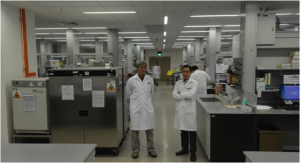New research findings have provided helpful conclusions to help you become a more conscientious consumer of eggs. As summarized in this news article, findings related to animal health, consumer health, worker health, environmental impact, and affordability are outlined. The three housing types they looked at were battery cages, enriched colony housing (arguably more humane than …
There is an interesting new open access paper on urban ecosystems out in Biology Letters: Exoskeletons and economics: indoor arthropod diversity increases in affluent neighbourhoods | Biology Letters No it is not directly about microbes but nobody’s perfect and many of the arthropods they look at are small and the story about biodiversity is (I …
In light of the Cold Fire that started yesterday evening in the central valley of California, I started to wonder, ‘what happens to microbes?!’ I found myself in a literature click hole of fantastic papers that studied how fire impacted soil microbial communities in several different ecosystems. What surprised me most is how fast researchers …
Just a quick post here. Multiple stories out about the Laying Hen Housing Research Project by the Coalition for Sustainable Egg Supply that maybe of interest. From: Hen housing trade offs: Food safety, workers and consumers | Food Safety News As it turns out, the food stores and restaurant chains promising to sell only cage-free eggs …
Professor Aubrey Tauer of City University of New York, LaGuardia Community College is running an crowdfunding campaign to support research conducted by her non-profit organization to better understand how sea turtle microbiomes vary in captivity and in wild populations. I asked her to write up something for microBEnet about the project. The campaign ends next week, so check it out …
Microbes and the built environment sensu stricto This short review in Trends in Microbiology is open access, very relevant for this blog, and received quite some press. Review: Buildings, Beneficial Microbes, and Health – Jordan Peccia, Sarah E. Kwan – Trends in Microbiology (OA) Bacteria and fungi in buildings exert an influence on the human …
The winners of the Bill & Melinda Gates Foundation Global Grand Challenges Round 16 were announced recently. Among the challenge topics included in this round of competition was Novel Approaches to Characterizing and Tracking the Global Burden of Antimicrobial Resistance. The Gates Foundation made six awards in this topic area: Christopher Mason of Cornell University (USA) will generate a global …
This is a guest post from Dr. Koh Tse Hsien who maintains the blog Microcosm and also is in the Pathology Department at Singapore General Hospital. Clinical microbiology and social media We are a diagnostic laboratory that provides bacteriology services to a busy 1600-bedded tertiary care hospital in Singapore (http://www.sgh.com.sg). We receive about 360,000 specimens a year. …
microBE.net is an awesome name, so I wasn’t that surprised to find that the CDC has it’s own MicrobeNet that they launched in 2013. MicrobeNet is a free online curated database of emerging bacteria and fungi that aims to improve reference diagnostics and pathogen identification. The database includes genetic sequence data (16S rRNA), biochemical data, morphological characteristics and antibiotic resistance profiles for about 2,400 species, as well …
About half the human population now lives in urban environments. In 2008, populations of more developed nations were about 74% urban, while about 44% of residents of less developed countries lived in urban areas. It is projected that 70% of the world population will be urban by 2050, with most urban growth occurring in less developed countries. While there …








